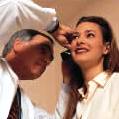
ARO Meeting Shares Latest Findings on Antioxidants
The 2009 Midwinter Meeting of the Association for Research in Otolaryngology begins today at Baltimore's Marriott Waterfront and will continue through Thursday. The event will feature the latest research findings from scientists supported by the National Institute on Deafness and Other Communication Disorders (NIDCD), among others, about ways to prevent hearing loss in older adults and people who are exposed to loud noise.
The findings being presented in Baltimore include brain scans of older adults by researchers at the Medical University of South Carolina that shed light on presbycusis (hearing loss brought on by aging), and two posters from researchers at the University of Michigan, the University of Florida, biosciences company OtoMedicine, and Washington University demonstrating temporary noise-induced hearing loss can be prevented in guinea pigs and mice by administering the antioxidants beta-carotene, vitamin C, and vitamin E and the mineral magnesium before the animals are exposed to a loud sound. The Washington University study showed those nutrients protect a structure in a mouse's inner ear that is involved in age-related hearing loss, according to NIDCD, which said the researchers are conducting clinical trials with college students, military personnel, and factory workers in Florida, Sweden, and Spain.
The posters are "Reduction in Permanent Noise-Induced Threshold Deficits in Mice Fed a Combination of Dietary Agents" and "Prevention of Temporary Noise-Induced Threshold Deficits Using Dietary Agents," both being presented on Wednesday.
The poster "Regulated Expression of Surface AMPA Receptors Reduces Excitotoxicity in Auditory Neurons," being presented tomorrow by NIDCD-funded researchers at the Massachusetts Eye and Ear Infirmary at Harvard Medical School, studied why auditory nerve cells temporarily reduce a key neurotransmitter receptor on their surfaces when exposed to loud noise, and whether this response can be blocked with a drug.